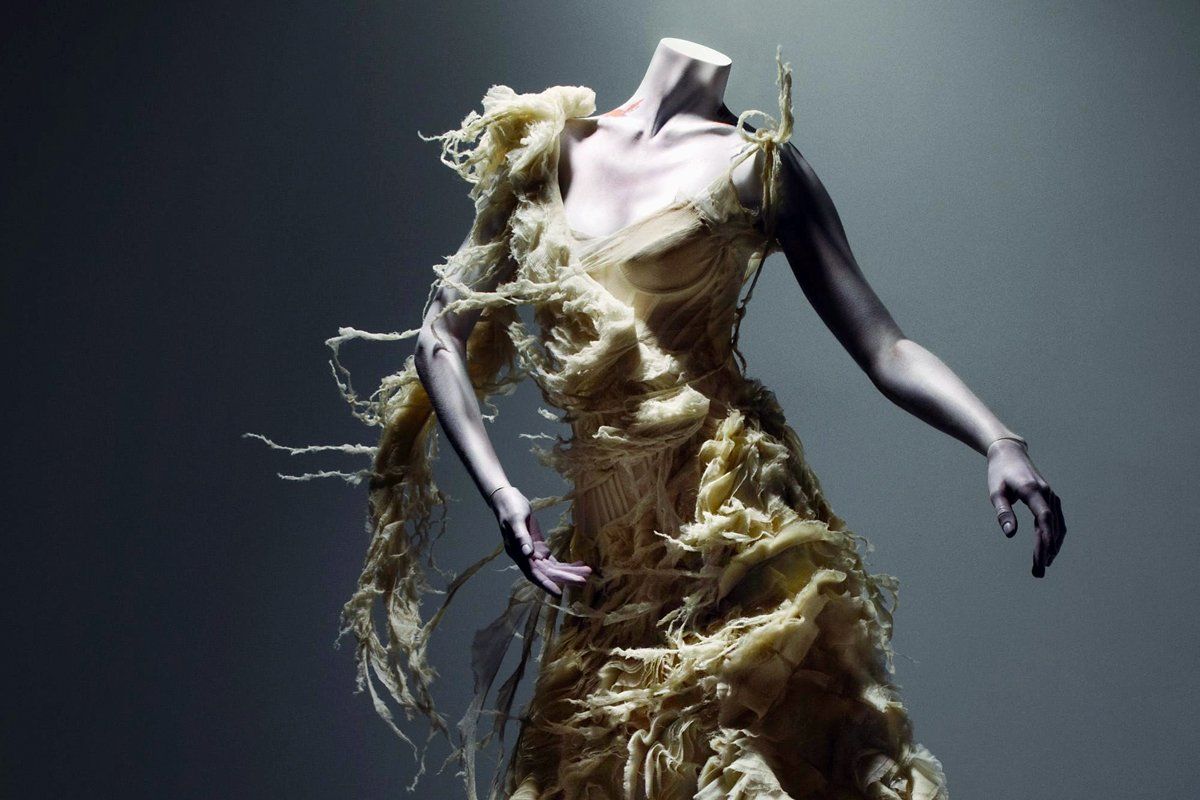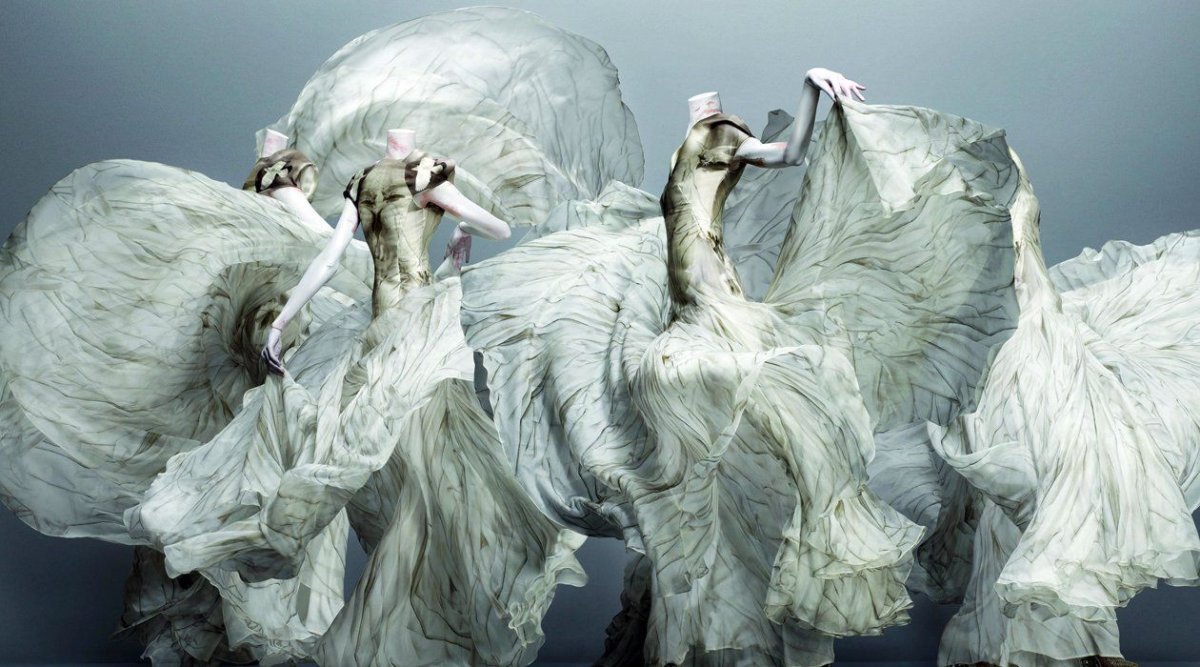
Trino Verkade is the auburn-haired keeper of the Alexander McQueen history—a living hard drive in a pair of skinny jeans. At once warm and straight-talking, she was the first employee hired by the celebrated British designer, known as Lee. Verkade was an inner-circle friend who was there at the start of McQueen's career in the early 1990s when he was living on social security above his sad-sack studio off Hoxton Square. And sadly, she was there at the end, last year, when he hanged himself in the million-dollar apartment he'd settled into in the elegant Mayfair district.
Now, Verkade is charged with organizing the late designer's creative affairs—sorting through and edifying for the historical record the complicated influences that made his ready-to-wear at once romantic and grotesque, morbid and sublime. She has been working with some urgency these last few months, because America's premiere fashion museum, the Costume Institute at the Metropolitan Museum of Art, is celebrating McQueen's work in an exhibition opening May 4.
McQueen was renowned for theatrical runway presentations, full of daring and bluster, that incorporated everything from live wolves to a hologram of model Kate Moss floating center stage like a ghostly apparition. "It all began with the show," Verkade says. "Lee saw the collections as both garments and mise-en-scène—plus the music. He'd never analyze what made sense or not. It was personal and emotional, and he never wanted to water it down."
The stagecraft and technical wizardry showed off McQueen's capabilities as a designer. He was a skilled tailor who could also drape a glorious gown without benefit of a pattern. And his personal story—his working-class beginnings, rough demeanor, uncensored rudeness—made him a dangerous and magnetic presence.
It's a testament to McQueen's talent that the Costume Institute has taken up his legacy. By tradition, it avoids exhibitions on living artists, and the last time it examined the life's work of a designer so soon after his death was with its Gianni Versace retrospective, which opened five months after the designer's murder in 1997. But curator Andrew Bolton wanted to tell McQueen's story before his atelier dispersed and the memories of him got fuzzy, doctored, and romanticized.
McQueen first gained prominence with his 1992 graduation collection—inspired by Jack the Ripper—for the master's program at London's Central Saint Martins College of Art and Design. Its dark sexuality dazzled the British media and captivated the eccentric and influential fashion editor Isabella Blow, who became McQueen's friend and unabashed champion. He soon made a name for himself internationally by introducing his "bumster" trousers—pants cut so low on the hips they revealed the cleavage of the buttocks. Editors assumed the silhouette was meant to shock the prudish, but Verkade says the designer's goal was to elongate a woman's torso to make her appear taller and more powerful.
With breathtaking speed, McQueen was welcomed into the fashion establishment. Gucci Group—now known as PPR Luxury Business Group—invested in McQueen's company and set it on a course for expansion into fragrances and a secondary line. But professional success was coupled with stress, anxiety, and personal tragedy. McQueen's troubled patron, Blow, committed suicide in 2007, and his mother, Joyce, died in February 2010. At 40, the designer took his own life the day before her funeral.

It was almost exactly a year later and a winter's haze still hovered over London when Verkade took me to the McQueen archives. The secure warren of bland storage rooms, filled with rolling racks, is tucked into the bowels of a discreet building not far from the company's metallic headquarters on Clerkenwell Road. The archives, from which most of the exhibition is drawn, are extensive, but they do not reach back to the beginning of McQueen's career. Many of the early garments were given away as payment to those who donated their labor. (Verkade has more than a few pieces in her closet.) Or sometimes, McQueen would rip apart his own work, reusing the fabric for the next collection. He came of age during a recession and was never a snob about materials, happily incorporating mussel shells plucked from the refuse of a local restaurant and straw beach mats spied during a holiday at the shore.
Like a host of today's designers, McQueen sketched clothes as a boy, was ridiculed for being gay, and was close to his mother, whose death, some who knew him have said, led to his suicide. But McQueen also rose from a rough-and-tumble working-class background in a country where class is not merely demographics but rather identity. His father was a cabbie; the family lived in public housing. And McQueen was neither dashing nor charismatic.
"I was more struck by his personal appearance than by any clothes he brought to the magazine," says his friend Plum Sykes, who met McQueen when she was an assistant at British Vogue. (Later, he'd make her wedding gown—with a five-foot train and one of his signature corsets.) "I think he was wearing a lumberjack shirt with the most low-class kind of schlubby-looking jeans falling down with a long key chain. He was quite podgy. He was like your classic, unemployed yob."
"He did not attempt to be posh; he gave no performance," Sykes says, contrasting him with those swashbuckling young designers whose talent for cocktail-party chatter is often more advanced than their draping skills. "His working-class roots…I think he was quite proud of them."
McQueen's connection to the working class was a truth burnished by mythology. His lack of money set him on a particular course, one that led him as a teenager to apprenticeships on Savile Row rather than classes at an expensive art school. He gained a sense of drama by working for a costumer. And later, he mastered lush femininity during his tumultuous tenure designing the couture collection at Givenchy in Paris. By the time of his death, McQueen had been lionized as the East End kid who grew up to dress aristocrats, starlets, and powerbrokers.
At a preview of the exhibition, in London's Ritz Hotel, Samantha Cameron, the prime minister's wife and an ambassador for the British Fashion Council, called McQueen "one of Britain's greatest fashion designers," likening the exhibition to a glorious cross-cultural exchange, with his work serving as diplomatic currency.
But at its core, his work was anything but diplomatic. His collections served as an exquisite rallying cry for the disenfranchised. McQueen's frocks were political in their reexamination of history—as with his "Highland Rape" collection, which addressed the subjugation of Scotland by the British. He engaged in discomforting confrontations over gender violence with aggressive collections that he touted as empowering women but that often seemed to dehumanize them in the process. And even as he gained entry into some of the most rarified salons, he remained acutely aware that the English can admire a bootstrap story without ever budging from their snobbish ways.
Indeed, his clothes reflected a cold realism about life's unfairness, its cruelties, and inevitable end. And his audiences were drawn to the beauty that emerged from that angst. "Lee combined two things, the superficiality of fashion and the sublime beauty of death," says artist Jake Chapman, a friend and creative confidant. "The reason his work has resonance was the self-destruction. We were watching someone kind of crumble."
One of McQueen's most powerful shows was for his spring 2004 collection, based on the 1969 Sydney Pollack film They Shoot Horses, Don't They? The movie tells a heartbreaking tale of aspirations and obsessions during the Depression; contestants in a dance marathon exhaust themselves physically and emotionally through their desperate grasping for an elusive prize. The film asks the provocative question of whether it is kinder to release people from their misery than to let them be destroyed by the hurt that hope so often delivers. McQueen's presentation was choreographed with models and professional dancers moving in a relentless cycle around a wooden dance floor. Sometimes their leaps and twirls were graceful and inspiring, other times they were gruesome and awkward. The clothes were, as always, magical: dilapidated dresses elaborately constructed from a patchwork of fabric; sorrowful chiffon dresses weighed down with tarnished sequins.
McQueen offered a clear-eyed vision of the harshness of life that, perhaps, only the working poor—or those from truly meager circumstances—are honest enough to acknowledge. While other designers, from John Galliano to Ralph Lauren, were romanticizing workers, vagabonds, and corporate strivers, McQueen was more inclined to highlight their calloused hands, bloodied feet, and shredded dignity.
"Lee undermined the proposition that art—or in his case, fashion—had to be positive," Chapman says. "He had ambitions and ideas that exceeded the superficiality of his industry."
Alexander McQueen: Savage Beauty will kick off with the Costume Institute's annual spring gala on May 2. The evening promises to be an exquisite swirl of contradictions—a thunderous storm of international social pomp in honor of a designer whose working-class background served as a source of pride and inspiration, as well as anger, frustration, and aggrievement.
"He had a malicious sparkle," Chapman says. "He had a righteous resentment of his circumstances and others' circumstances."
In that way, McQueen's work was full of loud, raw honesty. And whether beautiful or ugly, it continues to be irresistible.
Uncommon Knowledge
Newsweek is committed to challenging conventional wisdom and finding connections in the search for common ground.
Newsweek is committed to challenging conventional wisdom and finding connections in the search for common ground.





